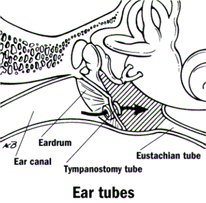Grommets
Procedures
Grommets
Also known as ventilation tubes, grommets are tiny plastic tubes which are inserted into a small opening in the ear drum. This is a short operation usually done under general anaesthetic in children and sometimes under topical or local anaesthetic in adults.

Grommets may be recommended in patients with
- Chronic glue ear – that causes a conductive hearing loss from persistent or recurrent middle ear fluid. This can lead to delayed speech development, learning difficulties, and behavioural problems.
- Ear infections – grommets decrease the frequency of infections in children who have troublesome recurrent otitis media.
- Ear drum retraction – this can cause a hearing loss, ear infections, erode the ossicular bones behind the drum or progress to a cholesteatoma. Grommets can prevent or reverse the drum retraction or stop it getting worse.
- Eustachian tube dysfunction – in some patients causes a feeling of blocked ears and difficulty equalising on flights and grommets may help in selected cases.
After surgery
Once your child has recovered and is wide awake, they are usually allowed to go home, often 1-3 hours after the operation. They can eat and drink normally after surgery. Children usually only require 1 to 2 days off school.
Any ear pain is usually mild and gets better within a few days and pain-relieving medicine is given if required.
There may be some blood and discharge from the ears afterwards but this should dry up within 3 days and if it persists contact the practice.
Your ENT Surgeon will want to see your child about 4 to 6 weeks after surgery, sometimes with a post-operative audiogram. Follow up visits are usually required until the grommet falls out.
It is recommended your child uses ear protection when swimming, shampooing, showering and bathing. Some children get sore ears and ear infections if unsterile water gets into the middle ear through the grommet. If an ear infection does occur the ear may discharge. Cupping ears to prevent the entry of water and shampoo during bath time is useful. Your doctor may suggest some simple precautions such as soft silicone or putty ear plugs, or cotton wool soaked with petroleum jelly. Using an ear wrap or head cap to hold the ear plugs in when swimming helps.
No swimming until checked at the first post-operative visit.
You may be prescribed ear drops (they may say “eye drops”) to put in the ears. First ensure that the drops are warmed to body temperature by putting it in your pocket or next to skin, then place the drops in the ear canal while lying on the side with the operated ear up, and pump them in by pushing on the tissue in front of the ear.
Children with grommets should be able to travel by air without any problems as the ear is not affected by changes in air pressure.
Grommets usually last between 3 to 12 months as the ear drum pushes them out and they fall out of the ear canal in time. The grommets only work while they are in so if the underlying ear problem persists another grommet may be required.
The hole that was present in the drum will close spontaneously in more than 95% of cases. Occasionally it does not close spontaneously and may need an operation to close it. Rarely a grommet may stay in place for more than 2 years in which case it should be reviewed as it may need to be removed.
If the ear develops a discharge or is sore then call the practice or see your GP. Usually treatment with antibiotic ear drops is effective in clearing the discharge. See “Treating a Discharging Ear” in the resources section on this website.
If you have any concerns after your procedure, please contact the following:
- Your Surgeon
- Auckland ENT Group on 09 522 2226
- Your Family Doctor / GP
- After hours – 24 Hour Medical Centre or Emergency Department
In case of an emergency – dial 111 for an ambulance.

